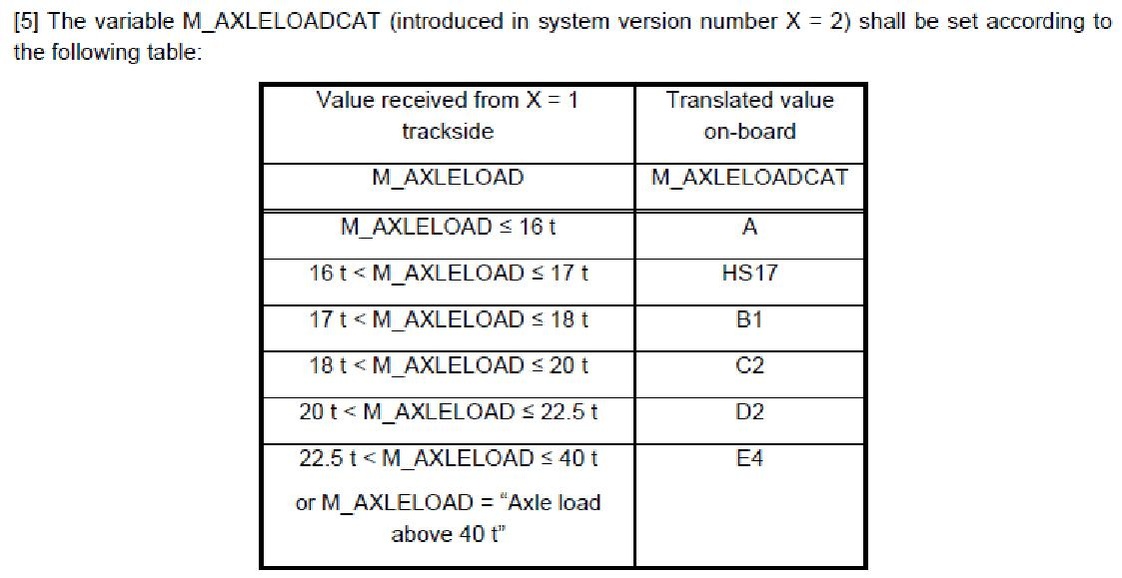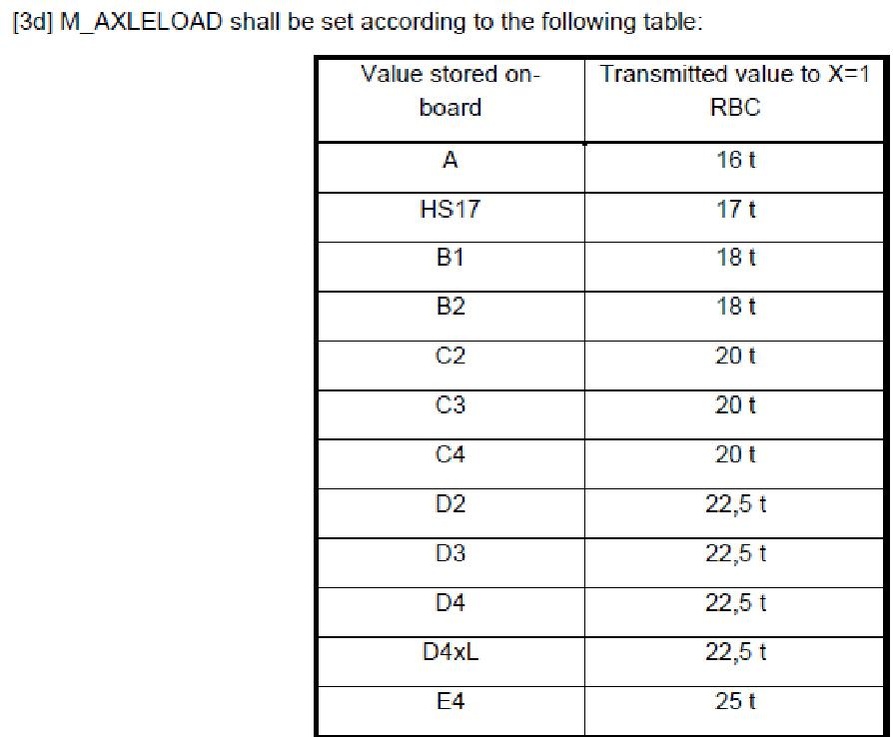User:RailML Coord Documentation/CO:speedProfile
Introduction
A <speedProfile> element specifies a train type for which the speed limit given by a <speedSection> element shall be valid. A speed profile valid for ETCS can be (among others):
- according to UNISIG SUBSET-026, versions 2.3.0, 3.4.0 or 3.6.0, section 3.11.3.2.1:
- a Basic Static Speed Profile (SPP) [ see section 2.2.1] or
- a Specific Static Speed Profile [ see section 2.2.2],
- according to UNISIG SUBSET-026, versions 2.3.0, 3.4.0 or 3.6.0, section 3.11.4:
- an Axle Load Speed Profile [ see section 2.3] or
- other speed profiles.
Note that the information of Temporary Speed Restrictions (TSR) according to UNISIG SUBSET-026, versions 2.3.0, 3.4.0 or 3.6.0, section 3.11.5, is provided in railML® by a <speedSection> element using attribute @isTemporary="true" and child element speedSection/isValid.
Static Speed Profiles for ETCS
Basic Speed Profile
- A Basic Static Speed Profile (SPP) is uniquely described by the railML® attribute @isBasicSpeedProfile. The modelling in railML® is
<common id="co_01"> <speedProfiles> <speedProfile id="ssp_Basic" isBasicSpeedProfile="true" mVersion="32"> <name name="ETCS Basic SSP" description="Basic ETCS static speed profile used by trains for which no Specific SSP matches" language="EN"/> </speedProfile> </speedProfiles> </common>
Specific Speed Profile
A Specific Static Speed Profile (SPP) is uniquely described by a value for “Cant Deficiency” SSP category (corresponds to UNISIG trackside variable NC_CDDIFF) and/or by a value for “other specific” SSP categories (corresponds to UNISIG trackside variable NC_DIFF).
The UNISIG variable NC_CDDIFF is represented by the the railML® attribute <speedProfile>/@maxCantDeficiency.
The UNISIG variable NC_DIFF in the meaning of ETCS Baseline 3 is represented by the combination of the railML® attributes <speedProfile>/<braking>/@airBrakeApplicationPosition and <speedProfile>/<trainType>/@type.
a) Cant Deficiency SSP category
- Below an example of the modelling in railML® for a “cant deficiency” SSP category
<Platzhalter>
b) “Other Specific” SSP category
- Below 3 examples of the modelling in railML® for an “other specific” SSP category (brake type depending category)
<Platzhalter>
c) Combinations of Cant Deficiency SPP and “Other Specific” SSP
An “ETCS operational Train Category” is uniquely described by the combination of the following 3 variables: “type of the train”, “type of brake” and “cant deficiency”.
Figure 2: ETCS Operational Train Categories (Source: TSI OPE Version 4)
Note: The presented page 79 of Figure 2 is taken from Appendix A (version 4) of the Technical Specifications „Operation and traffic management“ from 30/06/15 (File „Appendix A to TSI OPE (EN).pdf“ which is downloaded from https://www.era.europa.eu/activities/technical-specifications-interoperability_en).
The added information in Figure 2 concerning the UNISIG variables NC_DIFF and NC_CDDIFF is based on UNISIG SUBSET-026 (version 3.4.0 or 3.6.0), section 7.5.1.82.1 and 7.5.1.83.
- Examples
The ETCS operational train category “PASS 2” can be modelled in railML® as illustrated below:
<Platzhalter>
for ETCS Operational Train Category PASS 2 means NC_DIFF=2 with
<Platzhalter>
The ETCS operational train category “TILT 6” can be modelled in railML® as illustrated below:
<Platzhalter>
for ETCS Operational Train Category TILT 6 means NC_DIFF=2 with
<Platzhalter>
Static Speed Profiles for ETCS Baseline 2
An “International Train Category” according to ETCS Baseline 2 can be modelled in railML® as combination of the 3 railML® attributes speedProfile/@maxCantDeficiency (= A *), speedProfile/trainType/@type (= B *) and speedProfile/braking/@airBrakeApplicationPosition (= C *) according to the following transformation table.
Transformation table:
| 1 | 2 | 3 | 4 | 5 | 6 | 7 | 8 |
|
ETCS Baseline 2 | ETCS Baseline 3 | representation in railML® | ||||
| UNISIG variable | UNISIG variables | railML® variables | |||||
| NC_DIFF (BL2) | Q_DIFF | NC_CDDIFF | NC_DIFF (BL3) | A * | B * | C * | |
| 1 | 0 | 0 | 9 (=275mm) | (not used in P27 due to Q_DIFF=0) | 275 | (not used) | (not used) |
| 2 | 1 | 0 | 0 (=80mm) | (not used in P27 due to Q_DIFF=0) | 80 | (not used) | (not used) |
| 3 | 2 | 0 | 1 (=100mm) | (not used in P27 due to Q_DIFF=0) | 100 | (not used) | (not used) |
| 4 | 3 | 0 | 2 (=130mm) | (not used in P27 due to Q_DIFF=0) | 130 | (not used) | (not used) |
| 5 | 4 | 0 | 3 (=150mm) | (not used in P27 due to Q_DIFF=0) | 150 | (not used) | (not used) |
| 6 | 5 | 0 | 4 (=165mm) | (not used in P27 due to Q_DIFF=0) | 165 | (not used) | (not used) |
| 7 | 6 | 0 | 5 (=180mm) | (not used in P27 due to Q_DIFF=0) | 180 | (not used) | (not used) |
| 8 | 7 | 0 | 7 (=225mm) | (not used in P27 due to Q_DIFF=0) | 225 | (not used) | (not used) |
| 9 | 8 | 0 | 10 (=300mm) | (not used in P27 due to Q_DIFF=0) | 300 | (not used) | (not used) |
| 10 | 9 | 1 | (not used in P27 due to Q_DIFF=1) | Freight train braked in “P” position | (not used) | freight | P |
| 11 | 10 | 1 | (not used in P27 due to Q_DIFF=1) | Freight train braked in “G” position | (not used) | freight | G |
| 12 | 11 | 1 | (not used in P27 due to Q_DIFF=1) | Passenger train (braked in “P” position) | (not used) | passenger | P |
| 13 | 12 | 0 | 8 (=245mm) | (not used in P27 due to Q_DIFF=0) | 245 | (not used) | (not used) |
| 14 | 13 | 0 | 6 (=210mm) | (not used in P27 due to Q_DIFF=0) | 210 | (not used) | (not used) |
| 15 | 14 | The international train category 15 shall never be used. (This is according to the remark in “Assignment of values to ETCS variables” (ERA_ERTMS_040001) (e.g. version 1.30 from 22/02/21), section A.6.2: “This value shall never be used.”) |
Table 1: Transformation Table for "ETCS International Train Categories" (BL2 <-> BL3)
Note: The UNISIG variable NC_DIFF was re-defined in ETCS Baseline 3 with different semantic as used in ETCS Baseline 2.
Best Practice / Examples
Figure 3: Example Static Speed Profiles for a railway track section
- Extract of a corresponding railML® modelling according to ETCS Baseline 3 (part 1 of 2)
<Platzhalter>
- Extract of a corresponding railML® modelling according to ETCS Baseline 3 (part 2 of 2)
<Platzhalter>
Axle Load Speed Profiles for ETCS
Introduction
According to UNISIG SUBSET-026 (version 2.3.0 (d), 3.4.0 or 3.6.0), section 3.11.4, a speed limit valid for a speed section can be determined depending on the axle load. Trains with equal or higher axle load as defined for this speed section have to consider the axle load speed limit. Trains with lower axle load as defined for this speed section will ignore the axle load speed limit. It is possible to provide different speed limits for the same speed section, but each speed limit must be valid for an own axle load.
Best Practice / Examples
Example 1
The first example shows an axle load speed profile for ETCS baseline 2. The modelling in railML® is:
<Platzhalter>
For ETCS baseline 2, the axle load is presented by axle load categories, given by UNISIG variable M_AXLELOADCAT defined in SUBSET-026 (version 2.3.0(d)) section 7.5.1.62. The values of M_AXLELOAD (represented by railML® attribute @exceedsAxleLoad) can define a limit in tons (with resolution 0.5t) in the range from 0.0t to 40.0t (means 0.0t, 0.5t, 1.0t, …, 20.0t, …, up to 40.0t) and the special value “above 40.0t”.
Example 2
The second example shows an axle load speed profile for ETCS baseline 3. The modelling in railML® is:
<Platzhalter>
For ETCS baseline 3, the axle load is presented by axle load categories, given by UNISIG variable M_AXLELOADCAT defined in SUBSET-026 (version 3.4.0 or 3.6.0) section 7.5.1.62. The values of M_AXLELOADCAT (represented by railML® attribute @exceedsAxleLoadCat) can be for example: A, HS17, B1, B2, D4XL and others.
Additional Information
Notes
Open Issues
- The reason of the attribute “influence” in the <speedProfile> element is not clear.
- The complete section for Axle Load Speed Profile is based on railML® 3.2 beta-2 with additional new attribute @exceedsAxleLoad as suggested by Christian Rahmig in the railML® web meeting from 20th September 2021.
Additionally, the this document includes the new attribute @exceedsAxleLoadCat. The values of @exceedsAxleLoadCat should be defined by the existing “rail3:tLineCategoryExt” and added by the ETCS value “HS17” (see section 2.6).
The new attribute @exceedsAxleLoadCat is to be discussed in railML® working group “ETCS Track Net”: Should it be possible to provide both a) the “rail3:tLineCategoryExt” values and b) “tons limits” or only one of them?
Section to be deleted if discussions to axle load have been finished: Relationship between the Axle Load Profiles of ETCS Baseline 2 and 3
This section has no relation to the modelling of railML®. This section provides background information how the UNISIG variables concerning Axle Load Speed Profiles have to be transformed in case a train with an ETCS baseline 3 onboard unit is running on a railway line equipped with ETCS baseline 2 trackside devices.
The relation between the axle load speed profiles of M_AXLELOAD (as used in ETCS Baseline 2) and M_AXLELOADCAT (as used in ETCS Baseline 3) is presented by UNISIG SUBSET-026 (version 3.4.0 or 3.6.0), section 6.
The transformation from M_AXLELOAD to M_AXLELOADCAT is presented in SUBSET-026 (version 3.4.0 or 3.6.0), section 6.6.3.2.3 [5]:
Figure 4: Transformation from M_AXLELOAD to M_AXLELOADCAT (Source: UNISIG SUBSET-026, version 3.6.0, section 6.6.3.2.3 [5])
|
The transformation from M_AXLELOADCAT to M_AXLELOAD is presented in SUBSET-026 (version 3.4.0 or 3.6.0), section 6.6.3.4.5 [3d]:
Figure 5: Transformation from M_AXLELOADCAT to M_AXLELOAD (Source: UNISIG SUBSET-026, version 3.6.0, section 6.6.3.4.5 [3d])
Note: Figure 5 is applicable when a train equipped with ETCS onboard unit on basis of ETCS Baseline 3 sends a message to an RBC which works on basis of ETCS Baseline 2.


